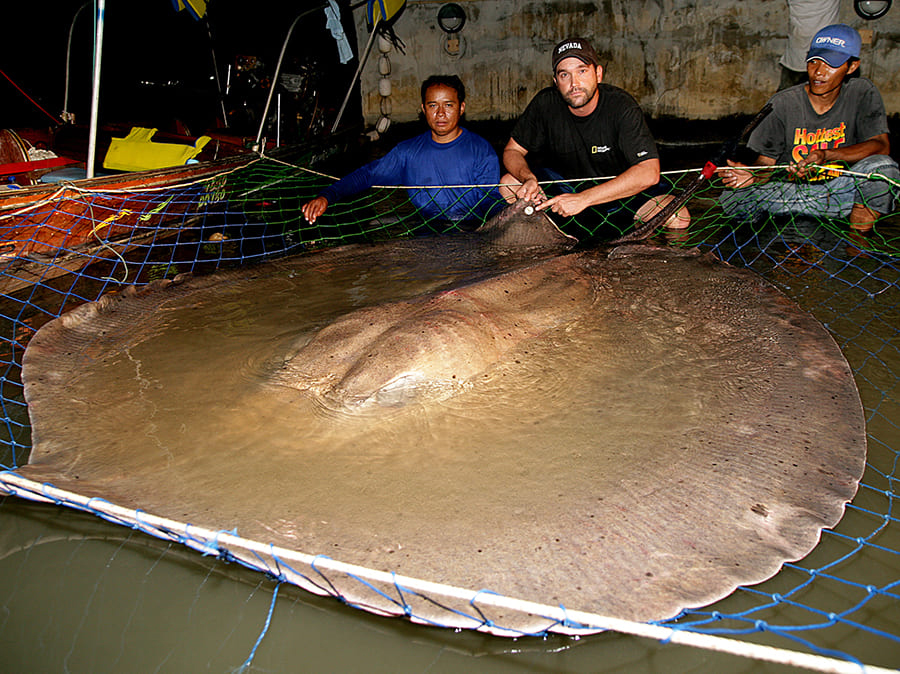If you couldn’t believe your eyes when you saw the recent photo of a purported record-breaking 771-pound stingray, you may have been on to something.
“While the photo is genuine and there’s no denying that this is a huge stingray, the stingray in the photo was never weighed,” University of Nevada, Reno conservation biologist Zeb Hogan said. He is lead researcher for the “Megafishes Project,” a joint venture with the National Geographic Society which aims to find, study, and protect the world’s largest freshwater fish.
News of the catch spread quickly. However, contrary to initial media reports, it is unknown if this fish, which was tagged and released in central Thailand on January 28, 2009 as part of the National Geographic expedition, is truly the world’s largest freshwater fish, he said. The fish, caught by volunteer angler Ian Welch from a small boat using a rod and reel, will be featured in an upcoming documentary airing on the National Geographic Channel.
“Surprisingly, we caught the stingray again four weeks later on Feb. 28,” Hogan said. “It’s still hasn’t been weighed so it still isn’t known if it’s a record breaker. We estimated the weight based on previous catches and simple ‘back-of-the-envelope’ calculations.”
Hogan, a Research Assistant Professor in the Department of Natural Resources and Environmental Science, along with his team of researchers and anglers on site at the time of capture, approximate the fish’s weight to be between 550-770 pounds. An even slightly larger fish than the one tagged would almost certainly be a world record freshwater fish, he said.
The stingray’s body, or disk, measured 6.6 feet wide by 6.9 feet long. The tail was missing. If it had been there, the ray's total length would have been between 14 and 16 feet, estimated Hogan. Last March he found a 14-foot-long ray near the Thai city of Chachoengsao.
“In terms of disk width, this is the second largest stingray I’ve seen, the largest was in Cambodia in 2003,” Hogan said. “This recent fish was very thick, so it may have weighed more.”
The big winged fish was caught the second time about four kilometers from the original site by local anglers who work with his team. Researchers immediately released it. The find could mean that the ray population is smaller, or less migratory, than originally believed. The tagging, tracking and sometime recapturing are how biologists estimate abundance of fish populations, Hogan said. Biologists continue to track the big fish’s movements using an array of underwater listening devices designed to detect tagged fish.
Hogan and his team have tagged 18 of this species of stingrays (Himantura chaophraya) as part of the recently established research project on the stingray in central Thailand for the University of Nevada, Reno, the Thai Department of Fisheries, the sport-fishing company Fishsiam and the National Geographic Society sponsored Megafishes Project. This species is listed as vulnerable to extinction by the International Union for Conservation of Nature (IUCN).
If he can get more funding for the project, Hogan hopes to eventually tag 40-50 stingrays for the research study, the first ever ecological study of the giant freshwater stingray which was discovered only 20 years ago. Freshwater giant stingrays are among the largest of the approximately 200 species of rays. They can be found in a handful of rivers in Southeast Asia and northern Australia.
“We aim to determine its conservation status, its abundance, its maximum size, whether or not it’s a true freshwater species, whether or not regional populations interact and its migratory patterns and critical habitat,” he said.
"It's clear that this species of giant freshwater stingray has the potential to be the largest freshwater fish in the world," Hogan said. The current record holder for world’s largest freshwater fish is a 646-pound Mekong giant catfish caught by fishermen in northern Thailand in 2005.
Hogan’s research has taken him to dozens of locations around the world, He works with a network of more than a hundred scientists in 17 countries to complete the project’s mission. About half of all megafish are in Asia, but Hogan's project also includes those in Australia, the Middle East, Europe and North and South America, including the Mekong River in southeastern Asia, the Mississippi River, the Nile in East Africa and the Amazon in South America.
The Megafishes Project is a 5-year initiative to find, study, and protect the world’s largest freshwater fish. A megafish is defined as any freshwater fish species that grows over 6 feet long or weighs more than 200 pounds. Approximately two dozen fish meet this criteria, including catfish, carp, trout, sturgeon, sawfish, paddlefish, gar and the giant freshwater stingray.












